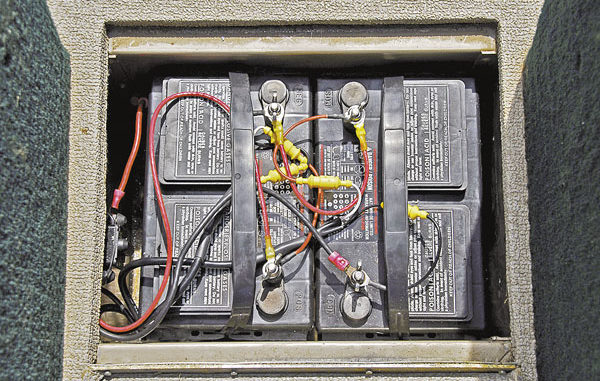
Two batteries don’t always deliver twice the running time of one.
Two common misconceptions can have you wondering where your trolling motor’s battery power went.
Have you ever felt that your trolling motor batteries short you on running time between battery charges? When you divide the amp hour (AH) ratings on your battery labels by your motor’s average amp draw, do you suspect your actual motor running time comes up short? Well, your suspicions are correct, and the devil is in the details.
You probably already know that a battery’s amp hour rating tells you how many hours a battery can carry a particular amp load. A 100 AH battery, for instance, should be able to carry a 5-amp load for 20 hours because 5 amps x 20 hours = 100 amp hours. What you may not know is that amp hour ratings are based on a specific length of time. They are calculated at, and are most accurate at, a 20-hour rate.
A German scientist named W. Peukert discovered back in 1897 that a lead-acid battery’s ability to deliver its total amp capacity is not exactly linear. He found that the total number of amps available varies with the rate at which the battery is discharged. Heavier loads deplete a battery’s amp capacity faster than strict amp hour calculations show they should.
While a 100 AH battery can carry a 5 amp load for 20 hours, the same battery cannot carry a 25 amp load for 4 hours even though 25 amps x 4 hours also equals 100 amp hours. The heavier 25 amp load depletes the battery in noticeably less than four hours, which means the battery has less than 100 AH of capacity at this higher discharge rate.
The reserve capacity (RC) rating on a deep-cycle battery is a better indicator of how long a battery can run trolling motors because it is based on a heavier amp draw rather than a time period. The RC rating tells you the number of minutes the battery can deliver a 25-amp load before it becomes officially discharged.
You can see evidence of Peukert’s Law just by looking at the label of a deep cycle battery and comparing the AH and RC ratings. Exide’s Megacycle MC31 battery, for instance, has a 100 AH rating and an RC rating of 200 minutes. If amp hours were truly linear and constant across all loads, this battery could carry a 25-amp load for four hours because 25 amps x 4 hours = 100 amp hours. Four hours is 240 minutes, but the battery’s label carries an RC rating of only 200 minutes, almost 20 percent less!
My best educated guess is that 25 amps is very close to the average amp draw of a trolling motor on an average fishing day — and I’d guess that the amount of motor running time you get from your batteries is about 20 percent less than what you feel you should get.
The second misconception many anglers have is the belief that a 24-volt trolling motor will run twice as long as a 12-volt model because it has two batteries. This isn’t true, and to make things even more confusing you can wire up two batteries in parallel (plus to plus and minus to minus) and they will a run a 12-volt motor twice as long.
A remarkable engineer, remarkable in that he could explain technical terms in plain enough English for me to understand them the first time, told me that the difference in voltage is the key. He suggested thinking of the amps in a battery as gallons of water and voltage as the pressure moving the water. A pressure of 12 volts drains one battery in the same amount of time that 24 volts (twice the pressure) drains two batteries. A 24-volt motor runs longer than a 12 volt model (but not twice as long) simply because it is more efficient. Most high-draw home appliances operate at 220 volts instead of 110 for the same reason.
I realize that all these details take up a lot of the average brain’s RAM, but memorizing them almost guarantees that if the opportunity presents itself you can win the cold beverage of your choice from your unsuspecting fellow angler.


